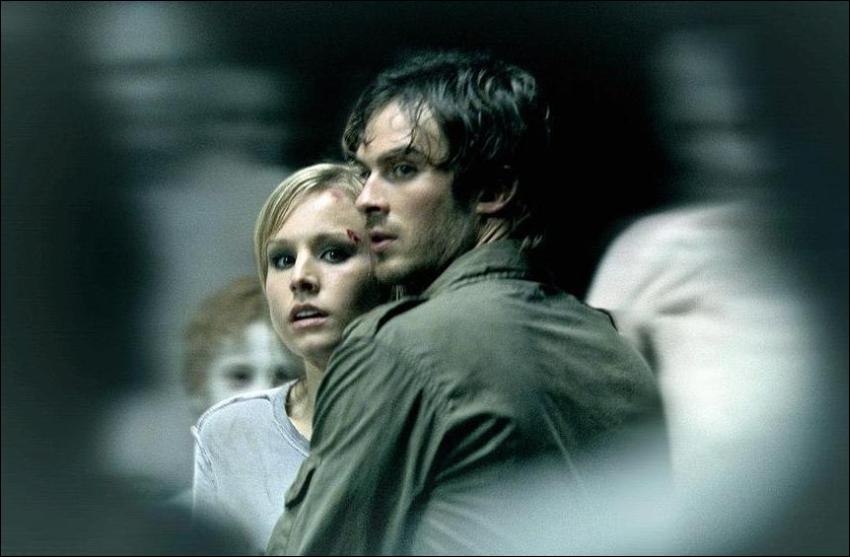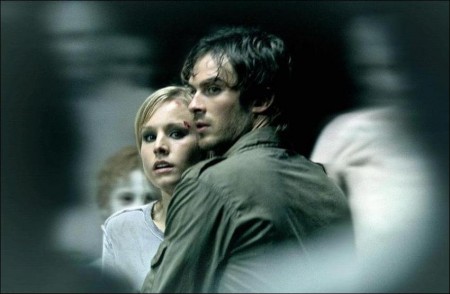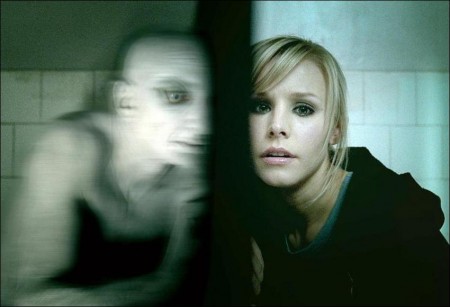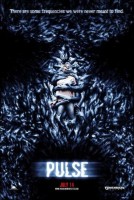Tagline: There are some frequencies we were never meant to find.
A website which at first appears to be merely a scary hoax with an irresistible marketing ploy turns out to be run by a sinister and deadly force. As more and more people tap into the site’s frightening images of the dead, the supernatural force controlling it begins to dominate the lives of the people that log on.
Based on the Japanese horror movie “Kairo,” “Pulse” centers on a group of college students who discover that a computer hacker friend of theirs unwittingly pirated a strange wireless signal that opened a doorway for a terrifying evil to cross over into the world. As it spreads, everyone in its path is consumed, and students must race to find a way to stop it.
Imagine our wireless technologies made a connection to a world beyond our own. Imagine that world used that technology as a doorway into ours. Now, imagine the connection we made can’t be shut down. When you turn on your cell phone or log on to your e-mail, they’ll get in, you’ll be infected and they’ll be able to take from you what they don’t have anymore – life. Kristen Bell (“Veronica Mars”), Christina Milian (“Love Don’t Cost A Thing”) and Ian Somerhalder (“Lost”) star in “Pulse,” a bone-chilling thriller hitting theatres on August 11th, 2006.
High speed data transfers, super wide-band, wifi — this is the wireless landscape. Huge volumes of information are traveling through the air. As we continue to explore these frequencies, we expose ourselves to realms we didn’t even know existed. We only fear what we can touch, hear, see or taste, but there is potentially so much more out there. What if our wireless technologies made a connection to a world beyond our own? What if, when you turn on your cell phone or log on to your email, you exposed yourself to forces beyond your worst fears? What if every connection = infection?
A Terrifying Tale Comes to Life
“Pulse” is based on the 2001 Japanese horror film “Kairo.” Written and directed by Kiyoshi Kurosawa, “Kairo” revolves around a group of Japanese teens who investigate a series of disappearnces linked to an internet webcam that promises visitors the chance to interact with the dead.
“What attracted me to this story is the message,” says director Jim Sonzero. “’Pulse’ illustrates the paradox of our technology; that which is supposed to bring us together – our communications technology – creates its opposite: alienation. We spend hours on our computers, emailing, texting, surfing, literally depositing bytes on each others machines, having the illusion of connection, but in reality we are not really interfacing on a human level. Virtual interaction is paradise lost. This is the central theme of this material. As we are seduced by our technology we are becoming more and more dependent on it, and it is changing us. ‘Pulse’ is a cautionary tale. Buyer beware – this is really happening to us. We are becoming less human and more isolated.”
“It’s a horror film that’s very haunting, mysterious and poetic,” says producer Joel Soisson. “We learned a lot from the original film. The Japanese excel at restraint, even in horror. But when they do deliver the scare, and you don’t expect it, it takes your breath away. I think we’ve captured that sort of attitude in ‘Pulse.’”
While still preserving the innate sense of dread that permeates Kurosawa’s film, the American version expands on the original concept. “We’ve tried to make it bigger and scarier, and I think it works,” says Soisson. “We want to make you jump out of your seat.”
Like “Kairo,” “Pulse” addresses the latent dangers of our fast-paced, wire free, digitally driven lifestyles and exploits our fears about technology. In “Pulse,” a group of friends stumble upon a campus wi-fi portal that doesn’t just connect them to the internet—it plunges them into a hi-tech nightmare. Leahy calls it “the ultimate computer virus.”
“‘Pulse’ leaves a lot of questions hanging about the technology that we’re using— like, is it really using us?” asks Kristen Bell, who stars in the film. “Some of this technology can think for itself, and that’s really frightening.”
For producer Soisson, these elements combine to make “Pulse” a terrifying frightfest that feeds into our hidden paranoia about modern living. “In our film,” says Soisson, “the terror is personal.”
Says Sonzero: “The scares in ‘Pulse’ are pure Lovecraft. The threat comes through the wifi. That means there is no safe haven for us, zero protection. These horrible beings come through thin air. Any wifi environment, cell phones PDA’s are conduits for the invasion.”
The Team
Hip commercial director Jim Sonzero was selected to direct “Pulse.” “We knew he would bring an incredible eye to the project,” says Soisson. “Jim understands what a frame of film can do better than anyone. He also has an affinity for actors and a great sense of story—things a commercial director doesn’t often get a chance to display.
That’s why he wanted to do this, along with loving the project. “He’s a well-rounded director,” continues the producer. “He gives you what you want, from the look, to the attitude, to the final payoff. He was a great discovery.” Sonzero was attracted to the film’s themes, particularly the idea that technology creates more of a sense of isolation than community. He views “Pulse” as a cautionary tale.
“It’s an illusion that we are brought together by communication devices. The more we interface with them, the more alienated we become,” he says. “Instead of us actually having physical contact with one another in this world of digital technology, we end up depositing fragments of our voices on each other’s machines. We communicate ‘virtually’ with each other. Exploring these ideas was really appealing to me, because I wanted to make people think on another level.”
Sonzero was also impressed by the original film. “Kurosawa’s vision was really haunting, and his scares were these unique slow burns,” he says. “I loved that.”
With Sonzero on board, casting could begin. The filmmakers assembled a fresh, young ensemble headed by Kristen Bell, the star of the popular UPN series “Veronica Mars.” Bell was enlisted to portray psychology major Mattie, who must investigate the chilling, cryptic e-mails she begins to receive from beyond the grave.
Sonzero desribes Kristen Bell as “a tremendous talent. I fell in love with her spirit in this film. She brings credibility and emotional resonance to the role of Mattie. When I viewed a scene she had done in a Mamet film called ‘Spartan’ and was blown away.”
“Mattie really provides the narrative of the film,” says Bell. “She witnesses the suicide of someone close to her at the beginning of the film, and it eats at her. She’s the one that stays driven to find out what’s really going on, and she doesn’t give in.”
Bell was drawn to the project after watching the Japanese version. “There’s something spectacularly creepy about ‘Pulse,’ because it deals with technology that we use every minute of every day,” she says. “The thought of something deadly infiltrating an object that you’re so comfortable with—your computer—is scary. There’s something very unsettling about the film, even after you’re done watching it.”
Adds Sonzero: “In close-ups, Kristen has the ability to convey several emotions simultaneously. She hooks you. The audience connects with her and is really scared for her in this film. Technically she is incredible.” And, he jokes, “I love her to death because I put her through hell on this show and she still talks to me.”
Ian Somerhalder, who played Boone Carlyle in the first season of the hit ABC series “Lost,” was then cast as computer geek Dexter, who ultimately becomes Mattie’s only ally in her search for the truth.
“Besides being a great young actor,” says Sonzero, “Ian Somerhalder is so darn good-looking, I wanted to pour battery acid on his face and force him to eat Krispy Kremes. Kristen said at the first table reading, ‘Jim casting a lead male actor that’s prettier than the female lead is just plain rude!’ But he is definitely more than a pretty face. This guy really cares about his craft, and works hard to make things as good as they can be. He also has the most amazing eyes; they literally light up the screen. I could light this guy with a flash light and he would still look great.”
Christina Milian, an actress in such films as “Be Cool” and “Love Don’t Cost a Thing,” was added to the cast as Isabel, Mattie’s best friend and roommate. “Isabel is the free spirit of the group. One night she might party with a guy; the next night she might get a pizza with Mattie,” says Milian. “She’s also the friend that’s skeptical. She tries to calm Mattie down and tell her there’s nothing happening, nothing to worry about…that she’s overthinking this thing with her ex-boyfriend, Josh, too much.”
Sonzero has praise for actress Christina Milian: “She was a joy to work with. What a talent. She is a rising superstar. Christina is fearless, always wiling to take chances, to go to the edge. Her attack scene is probably the scariest in the film, and to her credit, because she can convey pure terror like no-one else. She is the consummate Izzy: sexy, free and always ready to party without being cheap or tacky. You can feel the bond between these two characters; you feel that they really love each other.”
Jonathan Tucker, whose film credits include “Criminal” and “Hostage,” signed on to play depressed computer hacker Josh, who in Joel Soisson’s words “opens Pandora’s box in our film. He’s the guy that creates the problems that everyone else has to solve.”
Tucker agrees. “My character discovers a portal that opens up a world that he doesn’t expect to find, and that my friends have got to figure out how to close,” he says. “He falls on difficult psychological times because he discovered this opening that’s allowed some sort of evil spirits into his life.”
Adding a little comic relief to the group of friends is Stone, played by Rick Gonzalez, who most recently appeared in “Roll Bounce” and Steven Spielberg’s “War of the Worlds.”
“Stone is a cyber pirate, a hustler. He pirates DVDs and gains internet access into places that he shouldn’t,” Gonzalez says. “He and Josh run a little scam messing with university students test grades. They make a little money on the side.”
Samm Levine, former star of the hit NBC series “Freaks and Geeks,” signed on as Tim, who “has a super big crush on Mattie,” says the actor. “He’s been trying to make her notice him, but it’s really not working.”
Levine was also attracted to the idea that so intrigued Jim Sonzero—could the technological advances we use in our daily lives turn on us?
“We were trying to point out how technology and the internet is supposed to bring everyone together and make us one world,” says Levine. “But it really creates distance between people.”
Creating the Creep: The Look of “Pulse”
“One of the things that makes ‘Pulse’ stand out from others in its genre is the look of the film,” says Michael Leahy. “Even though Jim comes out of the commercial world, and this is his first feature, it’s a beautiful film to look at.”
Sonzero opted for a color palette that was decidedly desaturated. “I was going for cool blues, pewters, gunmetal grays, and black and white to set the mood,” he says.
In addition to a cool color palette, other elements contributed to a look that can only be described as unsettling for the viewer. Director of photography Mark Plummer and production designer Gary Matteson—like Sonzero, also from the commercial world—helped create the creepiness.
“The look of ‘Pulse’ is very unique, and I think that is a testament to the hard work and the eye of Jim Sonzero and Mark Plummer. Mark was the cinematographer on one of my favorite movies from the early 90’s, ‘After Dark My Sweet,’” says Leahy. “I think both of them came together and really made ‘Pulse’ stand out from the rest.”
Bringing “Pulse” to life also involved myriad visual effects: practical physical effects, lighting effects, and digital effects. “The concept of a virus coming off of any piece of technology posed a visual challenge because not only did it incorporate physical effects that you do on set, but also lighting effects and CGI digital effects,” says Leahy. “So it was a big bag of mixed elements that brought our ghosts to life.”
Sonzero had a full complement of tools at his disposal. “The world of visual effects is constantly changing and evolving. There are so many options that we have at our fingertips now that allow us to manipulate an image,” he says. “We were able to pioneer and go into areas that we haven’t gone into before.
“With the software packages that are available now,” he continues, “you don’t need a big operation to pull it off. You can explore and develop your concepts and creature effects on two or three Macs.”
Phantom design was one of the most important elements to get right. “When it came to phantom design and concept design, we were able to do a lot of research to develop a look for a phantom that had not been seen before,” says Sonzero.
Sonzero, veteran special makeup effects designer Gary Tunnicliffe, visual effects supervisor Kevin O’Neill and the effects house collaborated on the phantom design. “Gary designed the first phantom, and then we did some alterations on that, and ultimately Jim Sonzero made some changes,” says Michael Leahy. Perhaps not coincidentally, the phantoms bear a strange resemblance to Sonzero himself.
“Jim’s a very interesting looking guy. He’s got a shaved head. He’s got tattoos. He’s got radiantly white teeth, and in some ways the phantoms seemed to evoke that same look,” says Soisson. “After we put them through the effects mill they came out a little scarier. But the phantoms originally started off as, as I think, clones of Jim Sonzero.”
The phantoms also have their own chilling signature sound. “It’s best described as a reverse sucking, screaming sound that is very unique. It’s something you’ve never heard before,” says Sonzero. “It started with a shrill human scream and breathing, and then it was reversed, stretched, processed and modulated. It added a new layer of horror to the phantoms and monsters.”
Despite all of the dazzling, state-of-the-art effects, “In this movie, we’ve also gone for the kind of effect that is my favorite—the non-effect,” says Joel Soisson. “It’s something that you don’t realize is off or different until you think about it. Most of our effects are about taking things away. We’ve been very diligent to remove anything that feels comfortable.”
Some effects scenes were lifted right from the original. “There’s a benefit to doing remakes, and that is that if there’s something that is really good, you can steal it and no one will blame you,” says Soisson. “And the original ‘Pulse’ has a few of those scenes.”
PULSE represents a unique approach to the design and production of visual effects. Visual Effects Supervisor Kevin O’Neill worked early on with director Jim Sonzero to establish the look, and more importantly, the “feel” of the various vfx events. O’Neill comments, “…we decided that the visual effects for PULSE had several responsibilities…they would tease the audience, shock the audience, and finally transport the audience…”
“In each instance, our design philosophy fell back on the sense each effect produced, as much as the technical and practical story implication each sequence required. The “grit” of a shot had to be accomplished in order for it to find its way into the movie…”
In an effort to carry the unique pre-visualization into the production of the film, O’Neill enlisted cutting edge filmmakers in the field of avant-garde multi media production. “Jim responded well to the concept that our vfx subject matter (cell phones, computers, the internet) was a “carrier” of multi- media, so I tapped friends who were familiar with our production techniques but applied them to things like Club VJ’ing, multimedia presentation, Web design and avant-garde filmmaking. “
“When we were shooting, Jim had his iPod hooked into speakers, and he played very haunting, chilling stuff,” says Jonathan Tucker. “He wanted to create a certain energy before we shot—and even at some points while we shot. It was tremendously helpful. He was directing us without even saying anything.”
Pulse Original
Directed by: Kiyoshi Kurosawa
Screenplay by: Kiyoshi Kurosawa
Starring: Haruhiko Katô, Kumiko Aso, Koyuki, Kurume Arisaka, Masatoshi Matsuo, Shinji Takeda, Jun Fubuki Shun Sugata
Studio: Magnolia Pictures
Summary: A website, which at first appears to be merely a scary hoax with an irresistible marketing ploy, turns out to be run by a sinister and deadly force. As people repeatedly tap into the site’s frightening images of the dead, the supernatural force begins controlling their lives. View Pulse page.
These production notes provided by Dimension Films.
Pulse
Starring: Kristen Bell, Christina Milian, Ian Somerhalder, Steve Talley, Rick Gonzalez, Samm Levine, Jonathan Tucker
Directed by: Jim Sonzero
Screenplay by: Ray Wright
Release Date: August 11th, 2006
MPAA Rating: PG-13 for intense sequences of sci-fi terror, disturbing images, language, sensuality and thematic material.
Studio: Dimension Films
Box Office Totals
Domestic: $20,264,436 (67.8%)
Foreign: $9,643,249 (32.2%)
Total: $29,907,685 (Worldwide)




